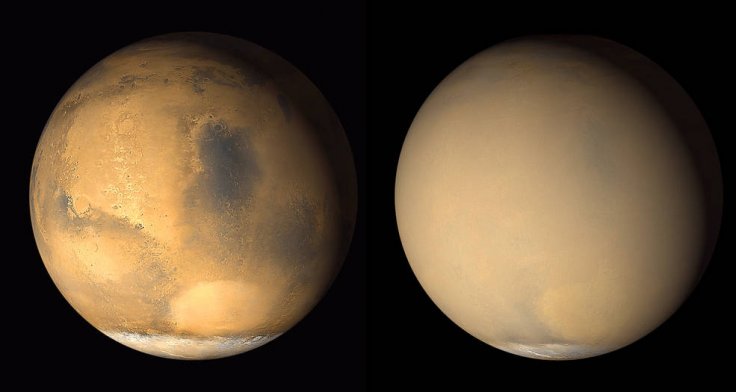
Mars watchers are anxiously waiting for a global dust storm on the Red Planet this year which can darken skies around the planet and provide a wider perspective of minerals and water vapor present in it. Researchers are hoping to get maximum information about the biggest phenomenon using the spacecraft currently probing the planet.
The global dust storm in Mars is marked by increasing amount of water vapor in the planet's middle atmosphere. Rising water vapor is carried up by the same air mass of the dust.
Researchers have found that presence of water vapor in the planet's middle atmosphere between 30 to 60 miles or 50 to 100 km results in the escape of hydrogen from its top atmosphere. NASA's Hubble Space Telescope and European Space Agency's Mars Express Orbiter has found similar patterns in past global dust storms as well.
Observations of NASA's Mars Reconnaissance Orbiter (MRO) during the most recent Martian global storm in 2007 have been used in studies. Research based on the data has helped in identifying the changes happening in the Martian atmosphere during a storm.
Even though Martian storms are common phenomenon during northern spring and summer, the global storms occur once in a while. Such storms occurred in 1977, 1982, 1994, 2001, and 2007. The currently predicted storm is expected to start this summer and will end by early 2019.
A Martian year is generally twice as long as an Earth year and has seasons similar to Earth.
Global storms and escaping gases from the atmosphere have resulted in the transformation of the Red planet from a wetter and warmer planet to an arid, frozen planet as seen today. NASA's MAVEN mission to Mars reached the planet in 2014 to study the process of atmospheric escape in the planet.
David Kass of NASA's Jet Propulsion Laboratory, Pasadena, California said, "It would be great to have a global dust storm we could observe with all the assets now at Mars, and that could happen this year."
However, all Mars researchers are not happy with the idea of a global dust storm as it could affect the current Martian missions. The solar-powered rover Opportunity needs to take shelter in safer grounds to save energy. All cameras on the rover also need to be adjusted to cope up with the lower visibility during the phenomenon.
The Mars Climate Sounder on MRO can scan the planet's atmosphere to detect dust and ice particles. It could detect the concentration of water vapor by sensing temperature variations. The sounder's data has shown a slight increase in middle-atmosphere water vapor during regional dust storm while 2007 global storm showed a major increase in water vapor levels by hundred times in higher altitudes.
MAVEN and Mars Express have found seasonal variation due to the loss of Hydrogen from the atmosphere contradicting the earlier belief that solar winds' charged particles cause the loss. Researchers currently believe that dust storms' hoisting of water vapor to higher altitudes result in the seasonal pattern of hydrogen escape.









